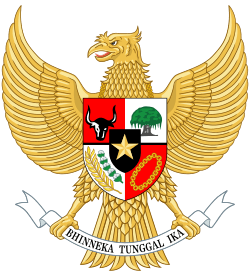First Sjahrir Cabinet
The first Sjahrir Cabinet (Indonesian: Kabinet Sjahrir Pertama) was the second Indonesian cabinet, named after the Prime Minister. It served from November 1945 to February 1946.
| First Sjahrir Cabinet | |
|---|---|
2nd Cabinet of Indonesia | |
| Indonesian Government (Executive Branch) | |
 | |
| Date formed | 11 November 1945 |
| Date dissolved | 28 February 1946 |
| People and organisations | |
| Head of state | Sukarno |
| Head of government | Sutan Sjahrir |
| No. of ministers | 16 |
| Member party | Indonesian Socialist Party Parkindo Masyumi Party |
| Status in legislature | Coalition |
| History | |
| Predecessor | Sukarno |
| Successor | Sjahrir II |
| ||
|---|---|---|
|
Pre-independence
|
||
|
Cabinets
|
||
|
Revolts Domestic Foreign policy
|
||
|
Speeches
|
||
|
Family
|
||
|
Media and legacy
|
||
Background
The first Sjahrir cabinet was established following the 11 November 1945 demand from the Central Indonesian National Committee, which was the de facto legislature, that the cabinet be responsible to it, not to President Sukarno. The existing cabinet was dismissed and Sutan Sjahrir was asked to become prime minister. He agreed to do so on the condition he was allowed to select his own cabinet. The cabinet lineup was announced on 14 November 1945.[1][2]
Composition
None of the ministers had served in the previous cabinet. The government was intended to be inclusive, with representation from the nationalist and the religious parties, the latter grouping being represented by the PSII.[3]
| Portfolio | Minister | Took office | Left office | Party | |
|---|---|---|---|---|---|
| Prime Minister Minister of Home Affairs Minister of Foreign Affairs | Sutan Sjahrir | 11 November 1945 | 28 February 1946 | Socialist | |
| Minister of People's Security | Amir Sjarifuddin | 11 November 1945 | 28 February 1946 | Socialist | |
| Minister of Defense | Amir Sjarifuddin | 28 February 1946 | 3 January 1946 | Socialist | |
| Minister of Information | Amir Sjarifuddin | 11 November 1945 | 3 January 1946 | Socialist | |
| Mohammad Natsir | 3 January 1946 | 28 February 1946 | Masyumi | ||
| Minister of Finance | Soenarjo Kolopaking | 11 November 1945 | 5 December 1945 | Independent | |
| Soerachman Tjokroadisoerjo | 11 November 1945 | 28 February 1946 | Independent | ||
| Minister of Education | Todung Sutan Gunung Mulia | 11 November 1945 | 28 February 1946 | Parkindo | |
| Minister of Justice | Soewandi | 11 November 1945 | 28 February 1946 | Independent | |
| Minister of Social Affairs | Adjidarmo Tjokronegoro | 11 November 1945 | 28 February 1946 | Socialist | |
| Minister of Health | Dr. Darma Setiawan | 11 November 1945 | 28 February 1946 | Independent | |
| Minister of Welfare | Darmawan Mangoenkoesoemo | 11 November 1945 | 5 December 1945 | Socialist | |
| Soedarsono | 5 December 1945 | 28 February 1946 | Socialist | ||
| Minister of Public Works | Poetoehena | 11 November 1945 | 28 February 1946 | Parkindo | |
| Minister of Transportation | Abdoel Karim | 11 November 1945 | 28 February 1946 | Independent | |
| Minister of Religious Affairs | Rasjidi | 3 January 1946 | 28 February 1946 | Masyumi | |
| State Minister | Rasjidi | 11 November 1945 | 3 January 1946 | Masyumi | |
| Junior Minister of Foreign Affairs | Harmani | 11 November 1945 | 28 February 1946 | Independent | |
| Junior Minister of People's Security | Abdul Murad | 11 November 1945 | 28 February 1946 | Socialist | |
| Junior Minister of Defense | Soegiono Josodiningrat | 28 February 1946 | 3 January 1946 | Independent | |
Changes
There were several changes over the short life of this cabinet. On 5 December 1945, Finance Minister Soenarjo Kolopaking and Social Affairs Minister Adjidarmo Tjokronegoro resigned and were replaced by Soerachman Tjokroadisoerjo and Soedarsono respectively. On 3 January 1946, State Minister Rasjidi was appointed Minister of Religious Affairs, heading the new ministry established the same day. The following day, Muhammad Natsir took over Amir Sjarifuddin's job as Minister of Information. On 7 January 1946, Soegiono Josodiningrat was appointed to replace Junior Minister of People's Security Abdul Murad and the name of the ministry was changed to the Ministry of Defense.[4]
The end of the cabinet
The Sjahrir cabinet fell as a result of the conflict between the Struggle Front of opposition politician Tan Malaka and Sjahrir over the latter's readiness to compromise with the Dutch before their colonial army had left Indonesia. Tan Malaka demanded a cabinet of national unity which secured widespread public support, prompting Sjahrir's resignation on 28 February 1946.[5][6]
Notes
- Kahin (1952) p169
- Ricklefs (1982) p206
- Simanjuntak (2003) pp. 52-54
- Simanjuntak (2003) p25
- Simanjuntak (2003) pp. 26-28
- Kahin (1952) pp.175-176
References
- Kahin, George McTurnan (1952) Nationalism and Revolution in Indonesia Cornell University Press, ISBN 0-8014-9108-8
- Ricklefs (1982), A History of Modern Indonesia, Macmillan Southeast Asian reprint, ISBN 0-333-24380-3
- Simanjuntak, P. N. H. (2003), Kabinet-Kabinet Republik Indonesia: Dari Awal Kemerdekaan Sampai Reformasi (in Indonesian), Jakarta: Djambatan, pp. 23–28, ISBN 979-428-499-8.
